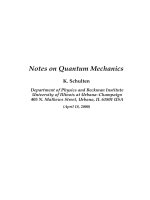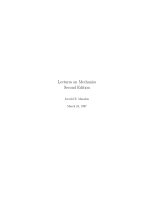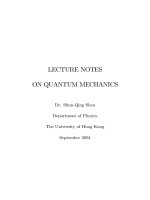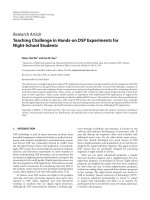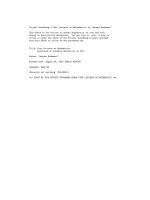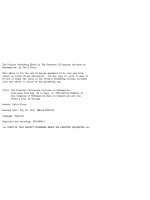- Trang chủ >>
- Khoa Học Tự Nhiên >>
- Vật lý
Lectures on quantum mechanics for mathematics students
Bạn đang xem bản rút gọn của tài liệu. Xem và tải ngay bản đầy đủ của tài liệu tại đây (2.07 MB, 248 trang )
Lectures on Quantum
Mechanics for
Mathematics Students
www.pdfgrip.com
www.pdfgrip.com
STUDENT MATHEMATICAL LIBRARY
Volume 47
Lectures on Quantum
Mechanics for
Mathematics Students
L. D. Faddeev
0. A. Yakubovskii
Translated by
Harold McFaden
AMS
American Mathematical Society
www.pdfgrip.com
Editorial Board
Gerald B. Folland
Robin Forman
Brad G. Osgood (Chair)
Michael Starbird
The cover graphic was generated by Matt Strassler with help from Peter
Skands. Processed through CMS by Albert De Roeck, Christophe Saout
and Joanna Weng. Visualized by Ianna Osborne. Copyright CERN.
2000 Mathematics Subject Classification. Primary 81-01, 8lQxx.
For additional information and updates on this book, visit
www.ams.org/bookpages/stml-47
Library of Congress Cataloging-in-Publication Data
Faddeev, L. D.
[Lektsii po kvantovoi mekhanike dlia studentov-matematikov. English]
Lectures on quantum mechanics for mathematical students / L. D. Faddeev,
O. A. Yakubovskii.
[English ed.].
p. cm. - (Student mathematical library ; v. 47)
ISBN 978-0-8218-4699-5 (alk. paper)
1. Quantum theory. I. Iakubovskii, Oleg Aleksandrovich. II. Title.
QC174.125.F3213 2009
530.12-dc22
2008052385
Copying and reprinting. Individual readers of this publication, and nonprofit
libraries acting for them, are permitted to make fair use of the material, such as to
copy a chapter for use in teaching or research. Permission is granted to quote brief
passages from this publication in reviews, provided the customary acknowledgment of
the source is given.
Republication, systematic copying, or multiple reproduction of any material in this
publication is permitted only under license from the American Mathematical Society.
Requests for such permission should be addressed to the Acquisitions Department,
American Mathematical Society, 201 Charles Street, Providence, Rhode Island 029042294, USA. Requests can also be made by e-mail to reprint -permissionaams.org.
© 2009 by the American Mathematical Society. All rights reserved.
The American Mathematical Society retains all rights
except those granted to the United States Government.
Printed in the United States of America.
The paper used in this book is acid-free and falls within the guidelines
established to ensure permanence and durability.
Visit the AMS home page at http:1/wv.ams.org/
10987654321
14131211 1009
www.pdfgrip.com
Contents
Preface
ix
Preface to the English Edition
P. The algebra of observables in classical mechanics
xi
§2.
States
§3.
Liouville's theorem, and two pictures of motion in
1
6
classical mechanics
13
§4.
Physical bases of quantum mechanics
15
§5.
A finite-dimensional model of quantum mechanics
27
States in quantum mechanics
Heisenberg uncertainty relations
Physical meaning of the eigenvalues and eigenvectors of
32
§6.
§7.
§8.
observables
§9.
§10.
§11.
§12.
§13.
36
39
Two pictures of motion in quantum mechanics. The
44
Schrodinger equation. Stationary states
Quantum mechanics of real systems. The Heisenberg
commutation relations
49
Coordinate and momentum representations
54
"Eigenfunctions" of the operators Q and P
60
The energy, the angular momentum, and other examples
of observables
63
v
www.pdfgrip.com
Contents
vi
§14.
§15.
§ 16.
§17.
§ 18.
§19.
§20.
§21.
§22.
§23.
§24.
§25.
§26.
§27.
§28.
§29.
§30.
§31.
§32.
§33.
§34.
§35.
§36.
The interconnection between quantum and classical
mechanics. Passage to the limit from quantum
mechanics to classical mechanics
69
One-dimensional problems of quantum mechanics. A
free one-dimensional particle
77
The harmonic oscillator
83
The problem of the oscillator in the coordinate
representation
87
Representation of the states of a one-dimensional
particle in the sequence space 12
90
Representation of the states for a one-dimensional
particle in the space D of entire analytic functions
94
The general case of one-dimensional motion
95
Three-dimensional problems in quantum mechanics. A
103
three-dimensional free particle
104
A three-dimensional particle in a potential field
106
Angular momentum
108
The rotation group
111
Representations of the rotation group
114
Spherically symmetric operators
Representation of rotations by 2 x 2 unitary matrices 117
Representation of the rotation group on a space of entire
120
analytic functions of two complex variables
123
Uniqueness of the representations Dj
Representations of the rotation group on the space
127
L2(S2). Spherical functions
130
The radial Schrodinger equation
136
The hydrogen atom. The alkali metal atoms
147
Perturbation theory
154
The variational principle
Scattering theory. Physical formulation of the problem 157
Scattering of a one-dimensional particle by a potential
159
barrier
www.pdfgrip.com
Contents
vii
Physical meaning of the solutions ik, and 02
Scattering by a rectangular barrier
164
Scattering by a potential center
Motion of wave packets in a central force field
The integral equation of scattering theory
Derivation of a formula for the cross-section
Abstract scattering theory
Properties of commuting operators
Representation of the state space with respect to a
complete set of observables
169
§46.
Spin
203
§47.
Spin of a system of two electrons
208
§48.
Systems of many particles. The identity principle
212
Symmetry of the coordinate wave functions of a system
of two electrons. The helium atom
215
Multi-electron atoms. One-electron approximation
217
223
The self-consistent field equations
Mendeleev's periodic system of the elements
226
§37.
§38.
§39.
§40.
§41.
§42.
§43.
§44.
§45.
§49.
§50.
§51.
§52.
Appendix: Lagrangian Formulation of Classical Mechanics
www.pdfgrip.com
167
175
181
183
188
197
201
231
www.pdfgrip.com
Preface
This textbook is a detailed survey of a course of lectures given in
the Mathematics-Mechanics Department of Leningrad University for
mathematics students. The program of the course in quantum mechanics was developed by the first author, who taught the course from
1968 to 1973. Subsequently the course was taught by the second author. It has certainly changed somewhat over these years, but its goal
remains the same: to give an exposition of quantum mechanics from
a point of view closer to that of a mathematics student than is common in the physics literature. We take into account that the students
do not study general physics. In a course intended for mathematicians, we have naturally aimed for a more rigorous presentation than
usual of the mathematical questions in quantum mechanics, but not
for full mathematical rigor, since a precise exposition of a number of
questions would require a course of substantially greater scope.
In the literature available in Russian, there is only one book
pursuing the same goal, and that is the American mathematician
G. W. Mackey's book, Mathematical Foundations of Quantum Mechanics. The present lectures differ essentially from Mackey's book
both in the method of presentation of the bases of quantum mechanics and in the selection of material. Moreover, these lectures assume
somewhat less in the way of mathematical preparation of the students. Nevertheless, we have borrowed much both from Mackey's
ix
www.pdfgrip.com
Preface
x
book and from von Neumann's classical book, Mathematical Foundations of Quantum Mechanics.
The approach to the construction of quantum mechanics adopted
in these lectures is based on the assertion that quantum and classical mechanics are different realizations of one and the same abstract
mathematical structure. The features of this structure are explained
in the first few sections, which are devoted to classical mechanics.
These sections are an integral part of the course and should not be
skipped over, all the more so because there is hardly any overlap of
the material in them with the material in a course of theoretical mechanics. As a logical conclusion of our approach to the construction
of quantum mechanics, we have a section devoted to the interconnec-
tion of quantum and classical mechanics and to the passage to the
limit from quantum mechanics to classical mechanics.
In the selection of the material in the sections devoted to applications of quantum mechanics we have tried to single out questions
connected with the formulation of interesting mathematical problems.
Much attention here is given to problems connected with the theory
of group representations and to mathematical questions in the theory
of scattering. In other respects the selection of material corresponds
to traditional textbooks on general questions in quantum mechanics,
for example, the books of V. A. Fok or P. A. M. Dirac.
The authors are grateful to V. M. Babich, who read through the
manuscript and made a number of valuable comments.
L. D. Faddeev and 0. A. Yakubovskii
www.pdfgrip.com
Preface to the English
Edition
The history and the goals of this book are adequately described in
the original Preface (to the Russian edition) and I shall not repeat
it here. The idea to translate the book into English came from the
numerous requests of my former students, who are now spread over
the world. For a long time I kept postponing the translation because
I hoped to be able to modify the book making it more informative.
However, the recent book by Leon Takhtajan, Quantum Mechanics
for Mathematicians (Graduate Studies in Mathematics, Volume 95,
American Mathematical Society, 2008), which contains most of the
material I was planning to add, made such modifications unnecessary
and I decided that the English translation can now be published.
Just when the decision to translate the book was made, my coauthor Oleg Yakubovskii died. He had taught this course for more
than 30 years and was quite devoted to it. He felt compelled to add
some physical words to my more formal exposition. The Russian
text, published in 1980, was prepared by him and can be viewed as
a combination of my original notes for the course and his experience
of teaching it. It is a great regret that he will not see the English
translation.
xi
www.pdfgrip.com
xii
Preface to the English Edition
Leon Takhtajan prepared a short appendix about the formalism
of classical mechanics. It should play the role of introduction for students who did not take an appropriate course, which was obligatory
at St. Petersburg University.
I want to add that the idea of introducing quantum mechanics
as a deformation of classical mechanics has become quite fashionable
nowadays. Of course, whereas the term "deformation" is not used
explicitly in the book, the idea of deformation was a guiding principle
in the original plan for the lectures.
L. D. Faddeev
St. Petersburg, November 2008
www.pdfgrip.com
§ 1. The algebra of observables in classical
mechanics
We consider the simplest problem in classical mechanics: the problem
of the motion of a material point (a particle) with mass m in a force
field V(x), where x(xl, x2i x3) is the radius vector of the particle. The
force acting on the particle is
F=-gradV=-ax.
The basic physical characteristics of the particle are its coordinates x1, x2, x3 and the projections of the velocity vector v(vl, v2, v3).
All the remaining characteristics are functions of x and v; for exam-
ple, the momentum p = mv, the angular momentum 1 = x x p =
mx x v, and the energy E = mv2/2 + V (x).
The equations of motion of a material point in the Newton form
are
(1}
dv
mdt
= - aV
dx
dt = v.
,
It will be convenient below to use the momentum p in place of the
velocity v as a basic variable. In the new variables the equations of
motion are written as follows:
aV
dp
(2)
dt
ax '
dx
dt
p
m
Noting that m = ap and
= aX , where H =
+ V (x) is the
Hamiltonian function for a particle in a potential field, we arrive at
the equations in the Hamiltonian form
(3)
dx_8H
dt
ap '
dp__aH
dt
ax
It is known from a course in theoretical mechanics that a broad
class of mechanical systems, and conservative systems in particular,
1
www.pdfgrip.com
L. D. Faddeev and 0. A. Yakubovskii
2
are described by the Hamiltonian equations
(4)
aH
aH
Pt = - qat
9t = apt ,
,
i = 1, 2, ... , n.
Here H = H(ql, ... , qn; pl,... , pn) is the Hamiltonian function, qt
and pt are the generalized coordinates and momenta, and n is called
the number of degrees of freedom of the system. We recall that for a
conservative system, the Hamiltonian function H coincides with the
expression for the total energy of the system in the variables qt and pt.
We write the Hamiltonian function for a system of N material points
interacting pairwise:
(5)
H
N
-
= E 2m
i=1
N
2
Pt
N
+ 1: Vj (xi - xj) + 1] V (xi).
t
i=1
Here the Cartesian coordinates of the particles are taken as the generalized coordinates q, the number of degrees of freedom of the system
is n = 3N, and V i (xt - xj) is the potential of the interaction of the
ith and jth particles. The dependence of Utj only on the difference
xt - xj is ensured by Newton's third law. (Indeed, the force acting on
ay;; = 9v,; _ -F t.)
the ith particle due to the jth particle is Ftj
ax;
aX;
The potentials V1(xt) describe the interaction of the ith particle with
the external field. The first term in (5) is the kinetic energy of the
system of particles.
For any mechanical system all physical characteristics are functions of the generalized coordinates and momenta. We introduce the
set 21 of real infinitely differentiable functions f (ql, ... , qn; pi,
, pn),
which will be called observables.l The set 21 of observables is obviously a linear space and forms a real algebra with the usual addition
and multiplication operations for functions. The real 2n-dimensional
space with elements (ql, . . , qn; pl, ... , pn) is called the phase space
and is denoted by M. Thus, the algebra of observables in classical
mechanics is the algebra of real-valued smooth functions defined on
the phase space M.
We shall introduce in the algebra of observables one more operation, which is connected with the evolution of the mechanical system.
.
'We do not discuss the question of introducing a topology in the algebra of observables. Fortunately, most physical questions do not depend on this topology.
www.pdfgrip.com
§ 1. The algebra of observables in classical mechanics
3
For simplicity the exposition to follow is conducted using the example
of a system with one degree of freedom. The Hamiltonian equations
in this case have the form
9= a- ,
(6)
p=--q
,
H=H(q,p)
The Cauchy problem for the system (6) and the initial conditions
plt=o = po
qlt=o = qo,
(7)
has a unique solution
q = q(qo, po, t),
(8)
p = p(qo, po, t)
For brevity of notation a point (q, p) in phase space will sometimes
be denoted by p, and the Hamiltonian equations will be written in
the form
(9)
A = v(µ),
where v(µ) is the vector field of these equations, which assigns to each
-aH
point a of phase space the vector v with components ari
aP
aq
The Hamiltonian equations generate a one-parameter commutative group of transformations
Gt : M --+ M
of the phase space into itself,2 where Gtµ is the solution of the Hamiltonian equations with the initial condition Gtplt=o = p. We have the
equalities
(10)
Gt+9 = GLG5 = G.Gt,
Gt 1 = G_t.
In turn, the transformations Gt generate a family of transformations
Ut : 2[ --+ 2[
of the algebra of observables into itself, where
(11)
Utf(p) = ft (IL) = f(Gtµ)
In coordinates, the function ft (q, p) is defined as follows:
(12)
ft (qo, po) = f (q (qo, po, t), p(qo, po, t) )
2We assume that the Hamiltonian equations with initial conditions (7) have a
unique solution on the whole real axis. It is easy to construct examples in which
a global solution and, correspondingly, a group of transformations C, do not exist.
These cases are not interesting, and we do not consider them.
www.pdfgrip.com
L. D. Faddeev and 0. A. YakubovskiT
4
We find a differential equation that the function ft (q, p) satisfies.
To this end, we differentiate the identity f,+t (µ) = ft (G,µ) with
respect to the variable s and set s = 0:
afs+t(µ)
as
aft(G9µ)
as
aft 6U)
9=o
at
aft aH
aq ap
9=o
aft aH
ap aq
Thus, the function ft (q, p) satisfies the differential equation
aft _ aHaft
at
ep aq
(13)
aHaft
aq ap
and the initial condition
ft(q,p)It=o = f(q,p)
(14)
The equation (13) with the initial condition (14) has a unique solution, which can be obtained by the formula (12); that is, to construct
the solutions of (13) it suffices to know the solutions of the Hamiltonian equations.
We can rewrite (13) in the form
dtt = {H, ft},
where {H, ft} is the Poisson bracket of the functions H and ft. For
arbitrary observables f and g the Poisson bracket is defined by
(15)
8f ag
{f, 9} = ap aq
of ag
aq ap
and in the case of a system with n degrees of freedom
of ag
{f,9}Captagi
of ag l
agtapt/
We list the basic properties of Poisson brackets:
1)
{ f, g + \h} = { f, g} + A{f, h} (linearity);
2)
{f , g} = -{g, f } (skew symmetry);
3)
{ f, {g, h}} + {g, {h, f }} + {h, {f, g}} = 0 (Jacobi identity);
4) {f,gh} =g{f,h}+ {f,g}h.
www.pdfgrip.com
§ 1. The algebra of observables in classical mechanics
5
The properties 1), 2), and 4) follow directly from the definition
of the Poisson brackets. The property 4) shows that the "Poisson
bracket" operation is a derivation of the algebra of observables. Indeed, the Poisson bracket can be rewritten in the form
{f,g}=Xfg,
where X f = a v -
ap is a first-order linear differential operator,
and the property 4) has the form
X fgh = (X fg)h + gX fh.
The property 3) can be verified by differentiation, but it can be proved
by the following argument. Each term of the double Poisson bracket
contains as a factor the second derivative of one of the functions
with respect to one of the variables; that is, the left-hand side of
3) is a linear homogeneous function of the second derivatives. On
the other hand, the second derivatives of h can appear only in the
sum If, {g, h}} + {g, {h, f}} = (X fX9 - X9X f)h, but a commutator
of first-order linear differential operators is a first-order differential
operator, and hence the second derivatives of h do not appear in the
left-hand side of 3). By symmetry, the left-hand side of 3) does not
contain second derivatives at all; that is, it is equal to zero.
The Poisson bracket If, g} provides the algebra of observables
with the structure of a real Lie algebra.3 Thus, the set of observables
has the following algebraic structure. The set 21 is:
1) a real linear space;
2) a commutative algebra with the operation f g;
3) a Lie algebra with the operation If, g}.
The last two operations are connected by the relation
If, gh} = If, g}h + g{f, h}.
The algebra 21 of observables contains a distinguished element,
namely, the Hamiltonian function H, whose role is to describe the
3We recall that a linear space with a binary operation satisfying the conditions
1)-3) is called a Lie algebra.
www.pdfgrip.com
L. D. Faddeev and 0. A. Yakubovskii
6
variation of observables with time:
dtt = {H, ft}.
We show that the mapping Ut : 21 - 21 preserves all the operations in 21:
h=f+g - ht=ft+gt,
h=f9- ht=ft9t,
h = if, 9} - ht = {ft, 9t};
that is, it is an automorphism of the algebra of observables. For
example, we verify the last assertion. For this it suffices to see that
the equation and the initial condition for ht is a consequence of the
equations and initial conditions for the functions ft and gt:
aht
at
(aft
+
ft' a9t
-W
{{H, ft}, gt} + {ft, {H, gt}} = {H, {ft, gt}} _ {H, ht}.
Here we used the properties 2) and 4) of Poisson brackets. Furthermore,
htlt_o = {ft,9t}It-o = {f,9}.
Our assertion now follows from the uniqueness of the solution of the
equation (13) with the initial condition (14).
§ 2. States
The concept of a state of a system can be connected directly with the
conditions of an experiment. Every physical experiment reduces to
a measurement of the numerical value of an observable for the system under definite conditions that can be called the conditions of the
experiment. It is assumed that these conditions can be reproduced
multiple times, but we do not assume in advance that the measurement will give the same value of the observable when the experiment
is repeated. There are two possible answers to the question of how to
explain this uncertainty in the results of an experiment.
1) The number of conditions that are fixed in performing the
experiments is insufficient to uniquely determine the results of the
measurement of the observables. If the nonuniqueness arises only
www.pdfgrip.com
§ 2. States
7
for this reason, then at least in principle these conditions can be
supplemented by new conditions, that is, one can pose the experiment
more "cleanly", and then the results of all the measurements will be
uniquely determined.
2) The properties of the system are such that in repeated experiments the observables can take different values independently of the
number and choice of the conditions of the experiment.
Of course if 2) holds, then insufficiency of the conditions can only
increase the nonuniqueness of the experimental results. We discuss
1) and 2) at length after we learn how to describe states in classical
and quantum mechanics.
We shall consider that the conditions of the experiment determine
the state of the system if conducting many repeated trials under these
conditions leads to probability distributions for all the observables.
In this case we speak of the measurement of an observable f for a
system in the state w. More precisely, a state w on the algebra Ql of
observables assigns to each observable f a probability distribution of
its possible values, that is, a measure on the real line R.
Let f be an observable and E a Borel set on the real line R. Then
the definition of a state w can be written as
f, E - wf (E)
We recall the properties of a probability measure:
(1)
0 < wf (E) < 1,
wf (0) = 0,
wf (R) = 1,
and if E1 fl E2 = 0, then wf(El U E2) = wf(E1) +wf(E2).
Among the observables there may be some that are functionally
dependent, and hence it is necessary to impose a condition on the
probability distributions of such observables. If an observable cp is
a function of an observable f, cp = c,(f ), then this assertion means
that a measurement of the numerical value of f yielding a value fo is
at the same time a measurement of the observable cp and gives for it
the numerical value cpo = cp(fo). Therefore, w f(E) and ww(f) (E) are
connected by the equality
(2)
WW(f) (E) = wf (`p-1(E)) ,
www.pdfgrip.com
L. D. Faddeev and 0. A. Yakubovskii
8
where W-' (E) is the inverse image of E under the mapping cp.
A convex combination
(3)
wf(E) = awl f(E) + (1 - a)w2f(E),
0 < a < 1,
of probability measures has the properties (1) for any observable f
and corresponds to a state which we denote by
(4)
w = awl + (1 - a)w2.
Thus, the states form a convex set. A convex combination (4) of
states wl and w2 will sometimes be called a mixture of these states.
If for some state w it follows from (4) that wl = w2 = w, then we
say that the state w is indecomposable into a convex combination of
different states. Such states are called pure states, and all other states
are called mixed states.
It is convenient to take E to be an interval (-oo, )%] of the real
axis. By definition, wf(.1) = wf((-oo,.1]), and this is the distribution
function of the observable f in the state w. Numerically, w f (A) is the
probability of getting a value not exceeding A when measuring f in
the state w. It follows from (1) that the distribution function wf(.1)
is a nondecreasing function of .\ with w f (-oo) = 0 and w f (+oo) = 1.
The mathematical expectation (mean value) of an observable f
in a state w is defined by the formula 4
(f w) = fAdwf().
00
We remark that knowledge of the mathematical expectations for
all the observables is equivalent to knowledge of the probability distributions. To see this, it suffices to consider the function 0(A - f) of
the observables, where 0(x) is the Heaviside function
x'> 0,
10, x < 0.
r1,
It is not hard to see that
(5)
wf(A) = (0(A - f)Iw)
4The notation (f I w) for the mean value of an observable should not be confused
with the Dirac notation often used in quantum mechanics for the scalar product (gyp, 10)
of vectors.
www.pdfgrip.com
§ 2. States
9
For the mean values of observables we require the following conditions, which are natural from a physical point of view:
1) (CIw) = C,
(6)
2)
(f + Ag I w) _ (f I w) + A(9
3)
(f2 I w) , 0.
If these requirements are introduced, then the realization of the
algebra of observables itself determines a way of describing the states.
Indeed, the mean value is a positive linear functional on the algebra
21 of observables. The general form of such a functional is
(7)
(f 1W) =
f (p, q) du,, (p, q),
IM
where di1 (p, q) is the differential of the measure on the phase space,
and the integral is over the whole of phase space. It follows from the
condition 1) that
(8)
JM
dµ,, (p, q) = P,, (M) = 1.
We see that a state in classical mechanics is described by specifying a probability distribution on the phase space. The formula (7)
can be rewritten in the form
(9)
(f I w) =
fm
f(p,q)P. (p,q)dpdq;
that is, we arrive at the usual description in statistical physics of a
state of a system with the help of the distribution function p, (p, q),
which in the general case is a positive generalized function. The
normalization condition of the distribution function has the form
(10)
fP(P,)dPd=1.
In particular, it is easy to see that to a pure state there corre-
sponds a distribution function
P(p,q) = 6(q - po) 6(p - po),
where b(x) is the Dirac b-function. The corresponding measure on
the phase space is concentrated at the point (qo, po), and a pure state
is defined by specifying this point of phase space. For this reason the
www.pdfgrip.com
10
L. D. Faddeev and 0. A. YakubovskiT
phase space M is sometimes called the state space. The mean value
of an observable f in the pure state w is
(12)
(f Iw) = f(9o,Po).
This formula follows immediately from the definition of the b-function:
(13)
f (40, Po) = fM f (9, p) 6(q - 40) 5(p - Po) d4 dp.
In mechanics courses one usually studies only pure states, while
in statistical physics one considers mixed states, with distribution
function different from (11). But an introduction to the theory of
mixed states from the very start is warranted by the following circumstances. The formulation of classical mechanics in the language
of states and observables is nearest to the formulation of quantum
mechanics and makes it possible to describe states in mechanics and
statistical physics in a uniform way. Such a formulation will enable
us to follow closely the passage to the limit from quantum mechanics
to classical mechanics. We shall see that in quantum mechanics there
are also pure and mixed states, and in the passage to the limit, a
pure quantum state can be transformed into a mixed classical state,
so that the passage to the limit is most simply described when pure
and mixed states are treated in a uniform way.
We now explain the physical meaning of mixed and pure states in
classical mechanics, and we find out why experimental results are not
necessarily determined uniquely by the conditions of the experiment.
Let us consider a mixture
w=awl+(1-a)w2i 0
(14)
(f I w) = a(.f J W1) + (1 - a)(f I w2).
The formulas (14) and (3) admit the following interpretation. The
assertion that the system is in the state w is equivalent to the assertion
that the system is in the state w1 with probability a and in the state
w2 with probability (1 - a). We remark that this interpretation is
possible but not necessary.
www.pdfgrip.com
§ 2. States
11
The simplest mixed state is a convex combination of two pure
states:
P(q, p) = ab(q - ql) b(P - P1) + (1 - a) 6(q - q2) b(P - P2)
Mixtures of n pure states are also possible:
n
P(q,p)
n
ai6(q - qt) b(p - pi),
ai = 1.
ai > 6,
i=1
i=1
Here a; can be interpreted as the probability of realization of the pure
state given by the point qi, pi of phase space. Finally, in the general
unction can be written as
case the distribution function
P(q, p) =
Such an expression leads to the usual interpretation of the distribution function in statistical physics: fo p(q, p) dgdp is the probability
of observing the system in a pure state represented by a point in the
domain SZ of phase space. We emphasize once more that this interpretation is not necessary, since pure and mixed states can be described
in the framework of a unified formalism.
One of the most important characteristics of a probability distribution is the variance
(15)
o2 f = ((f - (f I
W))2
I w) _ (f2 I w) - (f I
U))2.
We show that mixing of states leads to an increase in the variance. A
more precise formulation of this assertion is contained in the inequalities
A2 f '> a021 f+ (1
(16)
-
(17)
A, f A"9 3 a0",fA',,g + (1 -
with equalities only if the mean values of the observables in the states
w1 and w2 coincide:
(fIwl)=(fIw2), (91w1)=(91w2).
In a weakened form, (16) and (17) can be written as
A 2f > min (A2 f, A2
(18)
1
(19)
,f),
L uf0,,9 > min(&1 f A,,19, 0112foll29)
www.pdfgrip.com
L. D. Faddeev and 0. A. Yakubovskii
12
The proof uses the elementary inequality
(20) cp(x)
= a + (1 - a)x2 - (a + (1 - a)x)2
'> 0,
-00 < x < 00,
with
(21)
cp(1) = 0,
W(x) > 0
for x :?t 1.
Using (14) and (20), we get that
f=(f2IW)-(fIW)2
o2
=a
(f2Iw1)+(1-a)(f2IW2)-[a(f
IW1)+(1-a)(f Iw2)]2
a (f2 I wl) + (1 - a)(f2 I W2) - a(f I w1)2 - (1 - a)(f I w2)2
= aA21 f + (1 - a)A22 f.
The inequality (16) is proved. The inequality (17) is a consequence
of (16). Indeed,
A2 fA2 g '> (aA2l f + (1 -
(1 - a)D22g)
[a0l,1f0'111g+ (1 - a)O-2fA-1,2g]2.
For pure states,
p(q,p) = b(q - go) 6(p - po),
(f I w) = f (qo, po),
A2 f = f2(go,po) - f2(go,po) = 0;
that is, for pure states in classical mechanics the variance is zero. This
means that for a system in a pure state, the result of a measurement of
any observable is uniquely determined. A state of a classical system
will be pure if by the time of the measurement the conditions of
the experiment fix the values of all the generalized coordinates and
momenta. It is clear that if a macroscopic body is regarded as a
mechanical system of N molecules, where N usually has order 1023,
then no conditions in a real physical experiment can fix the values of
qo and po for all molecules, and the description of such a system with
the help of pure states is useless. Therefore, one studies mixed states
in statistical physics.
Let us summarize. In classical mechanics there is an infinite set
of states of the system (pure states) in which all observables have
completely determined values. In real experiments with systems of a
www.pdfgrip.com

![Lecture notes on c algebras and quantum mechanics [jnl article] n lamdsman](https://media.store123doc.com/images/document/14/rc/rt/medium_6PjfnHupCQ.jpg)
